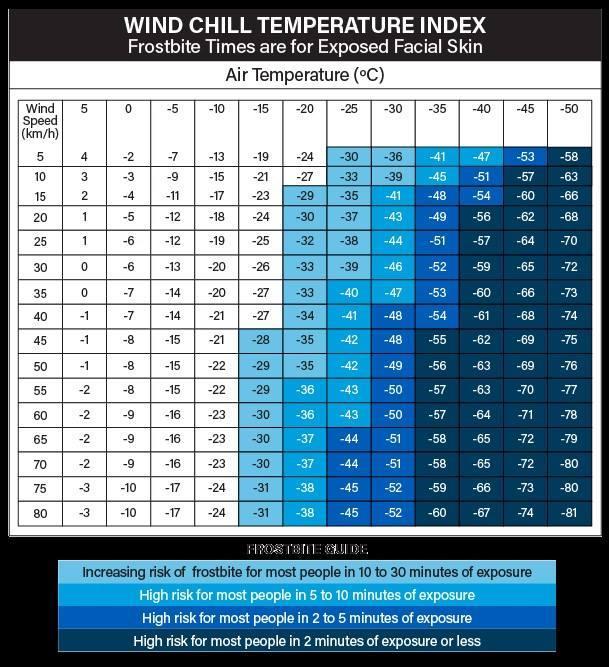In Canada, the legislation from some jurisdictions provide a range of acceptable temperatures for specific circumstances. In other cases, occupational health and safety jurisdictions use the Threshold Limit Values® for cold stress as published by the American Conference of Governmental Industrial Hygienists (ACGIH). Some Canadian jurisdictions have adopted these TLVs as occupational exposure limits and others use them as guidelines.
Where there are no maximum/minimum exposure limits for cold working environments, there are guidelines that can be used to conduct work/task assessments, create safe work plans, and monitor conditions to protect the health and safety of workers who may be exposed to cold temperatures. Where there are differences between the recommendations made by various organizations (and where there are no established limits or guidelines from your jurisdiction), employers are encouraged to choose a system that best provides protection for their workforce.
For example, ACGIH suggests a work-warming regimen when work is done continuously in the cold when the wind chill temperature is -7°C (19.4°F), heated warming shelters (tents, cabins, restrooms, etc) should be made available nearby. Workers should be encouraged to use these shelters, depending on the severity of the exposure. If signs of cold stress are noticed, return to the shelter immediately. For work at or below -12°C (10.4°F), work should include:
- Constant observation (supervisor or buddy system),
- Adjusting the pace or rate of work so that it is not too high and cause heavy sweating that will result in wet clothing
- Time for new employees to become accustomed to the conditions
- Adjusted to include the weight and bulkiness of the clothing when estimating work performance and weights to be lifted by the worker
- Arranged in such a way that sitting and standing for long periods is minimized
- instructions in safe work practices, re-warming procedures, proper clothing practices, proper eating and drinking habits, recognition of cold stress/frostbite, and signs and symptoms of hypothermia or excessive cooling of the body (including when shivering does not occur)
Source: CCOHS
Equipment Design
For work below the freezing point, metal handles and bars should be covered by thermal insulating material. Also, machines and tools should be designed so that they can be operated without having to remove mittens or gloves.
Surveillance and Monitoring
Every workplace where the temperature may fall below 16°C should be equipped with a suitable thermometer to monitor any further temperature changes. For colder workplaces with temperatures below the freezing point, the temperature should be monitored at least every 4 hours. For indoor workplaces, whenever the rate of air movement exceeds 2 meters per second (5 miles per hour) it should be recorded every 4 hours. In outdoor workplaces with air temperature below the freezing point, both air temperature and wind speed should be recorded.
Emergency Procedures
Procedures for providing first aid and obtaining medical care should be clearly outlined. For each shift, at least one trained person should be assigned the responsibility of attending to emergencies.
Education
Workers and supervisors involved with work in cold environments should be informed about symptoms of adverse effect exposure to cold, proper clothing habits, safe work practices, physical fitness requirements for work in cold, and emergency procedures in case of cold injury. While working in cold, a buddy system should be used. Look out for one another and be alert for the symptoms of hypothermia.
Source: BC WorkSafe: Occupational Health and Safety Regulations
Cold Exposure
7.33 Application - Sections 7.34 to 7.38 apply to a workplace if a worker is or may be exposed to:
- (a) thermal conditions that could cause cold stress or injury,
- (b) thermal conditions that could cause a worker's core body temperature to fall below 36°C (96.8°F), or
- (c) thermal conditions that are below the levels classified as "little danger" to workers in the criteria for the cooling power of wind on exposed flesh in the cold stress section of the ACGIH Standard.
[Enacted by B.C. Reg. 382/2004, effective January 1, 2005.]
7.34 Cold stress assessment and exposure control plan - If a worker is or may be exposed to the conditions specified in section 7.33, the employer must:
- (a) conduct a cold stress assessment to determine the potential for hazardous exposure of workers, using measures and methods that are acceptable to the Board, and
- (b) develop and implement a cold exposure control plan meeting the requirements of section 5.54(2).
[Enacted by B.C. Reg. 382/2004, effective January 1, 2005.]
7.36 Heated shelters - If a worker is exposed to a thermal environment with an equivalent chill temperature less than -7°C (19°F), as determined using the criteria for the cooling power of wind on exposed flesh in the cold stress section of the ACGIH Standard, a nearby heated shelter must be available to the worker.
If you feel your workplace is unsafe due to cold temperatures, contact the Union Office and your manager.
In Alberta: the recommendations are below:
Cold stress
Cold stress occurs when your internal body temperature is lowered. Cold stress can be dangerous to yourself and your co-workers.
Early warning signs
- Unusual “–umbles”: stumbles; mumbles; fumbles; grumbles
- Feeling cold and shivering
- Trouble moving your fingers, hands and toes
- Trouble doing tasks
- Loss of feeling or tingling in fingers and toes
- Frostnip, when the top layer of exposed skin freezes
- Severe cold stress signs: violent shivering; loss of muscle coordination, slow movements and laboured breathing; amnesia or confusion; chilblains: when exposed skin is blue or red, swollen and tingling; frostbite: when the skin freezes deeply; trenchfoot or trenchhand: caused by prolonged exposure to damp, cold environments; loss of consciousness
How to stay warm
- Cover exposed skin
- Work in sunny areas when possible
- Take breaks inside
- Wear good quality, insulated clothing
- Keep footwear dry
- Keep moving to generate body heat but stop before you sweat; if your inner clothing layer gets wet, you’ll lose heat
What employers can do
Cold weather is a workplace hazard. Like all hazards, employers must have a plan to control or eliminate dangers associated with working in the cold. Some things employers can do include:
- Providing an on-site heater or heated shelter
- Using a work/warm-up schedule
- Using a buddy system so workers don’t work alone in the cold
- Scheduling work during daylight hours
- Allowing workers to work at their own pace and take extra breaks if needed
- Educating workers on cold weather hazards, and plans in place to protect them
- Giving workers time to adjust before assigning a full work schedule in the cold
- Providing insulated clothing
Although the legislation and/or values listed above are recommendations, you can see there are very little variations between the various jurisdictions. It is still the responsibility of the company to provide a safe working environment.
At the end of the day, your safety is our primary concern, If you are experiencing any of the symptoms of Hypothermia, frostbite, or Cold Stress Contact your manager immediately and get to a warm place.
Your National Health And Safety Committee
Contact: safety@usw1944.ca

